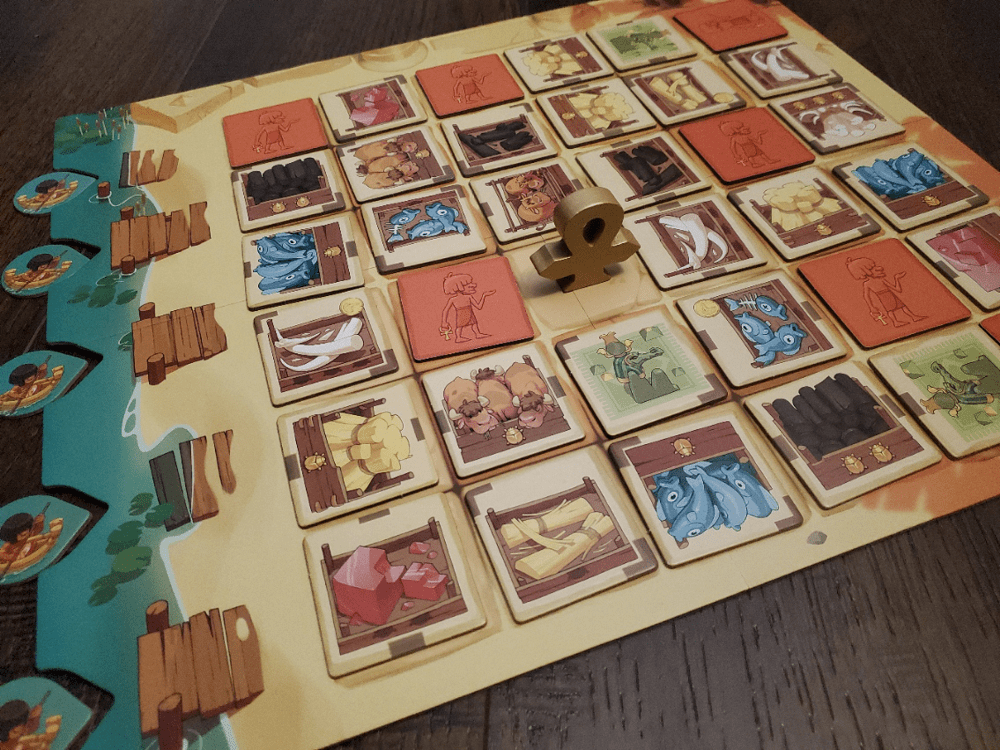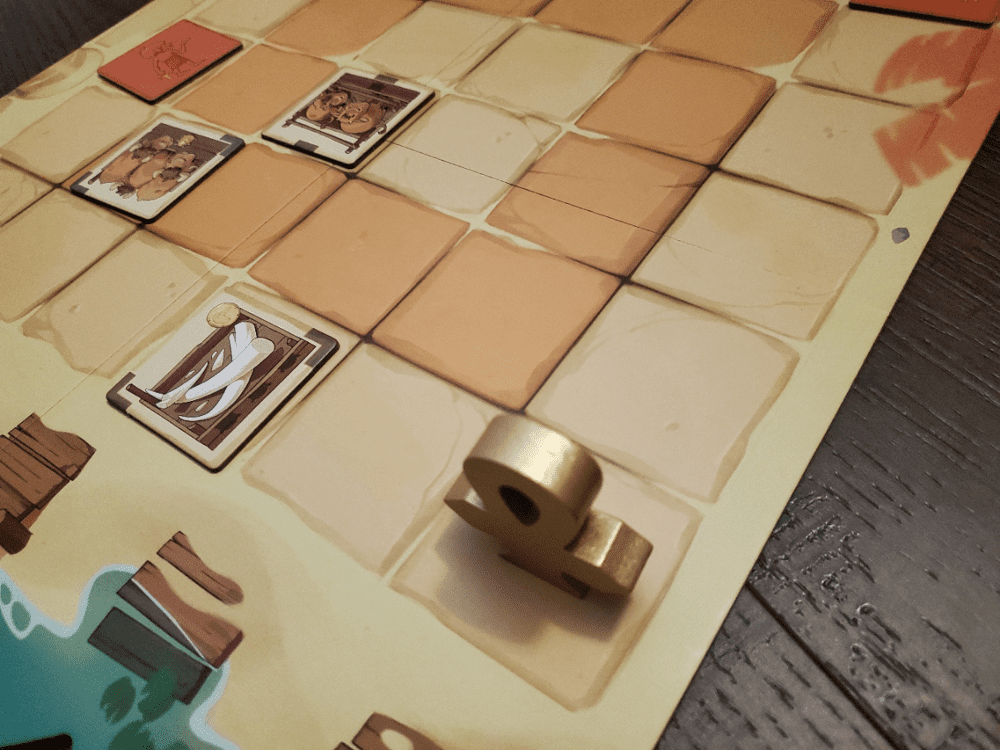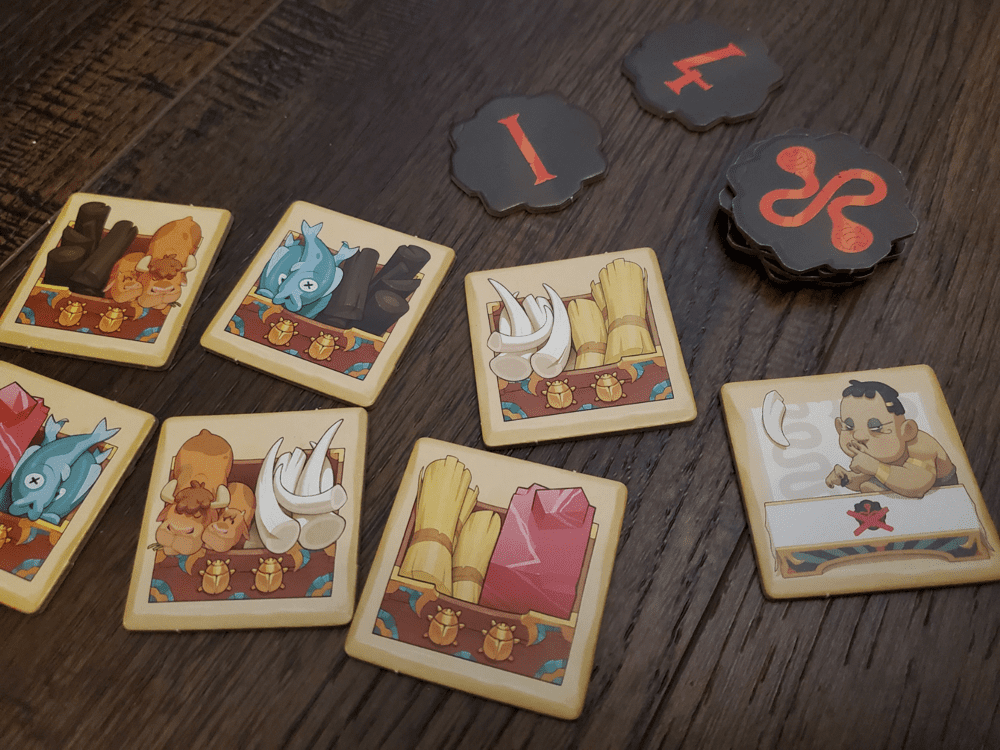If gaming through Egypt is your bag, well, there is no shortage of titles. Looking for a light game that will highlight your architectural prowess? Try Imhotep. Same question, but you’re going for more of a date night? Imhotep: The Duel. Same question, but less light? Egizia: Shifting Sands. Same question, but with a different slice of umph? Faiyum. After building temples all over the place, maybe you’d like to actually be the gods. Go for Ankh: Gods of Egypt. Want to come back centuries later to dig up all those temples and gods? Go for Thebes.
But if after all that building and fighting and settling and deifying, dying, and digging you find you’re interested in building again, maybe it’s time you took a look at Sobek: 2 Players from Pandasaurus Games. This specific title happens to be a refurbished and duel-ized version of a Bruno Cathala design from 2010—originally called Sobek—that, by most accounts, was OK.
The reprint gathers most of the core thematic elements and ideas behind the mechanical skeleton of Sobek and turns it into a lovely little duel that is more cute than killer, but has the potential for head games and interesting decisions. Now with an expansion on the market—Treasures of the Pharaoh—it’s time we took a peek at the ancient marketplace game about funding the temple to the god with the gator head.
Like so
Sobek: 2 Players takes place on a grid of 36 squares holding tiles. Players take turns either collecting a goods tile from the marketplace, laying a set of at least three tiles, or playing a Character tile to utilize a special ability. According to legend, the goods collected are spent building a humdinger of a temple in Faiyum, the region commonly associated with Sobek. Scoring, in the end, comes by looking at each set and multiplying the number of tiles by the number of golden scarabs adorning the crates—that, and any coins collected along the way.

When it comes to collecting goods, players are directed to the available tiles by the angle of the wooden Ankh pawn on the board. Each of the goods tiles features directional markings of an orthogonal or diagonal persuasion. After claiming a tile, the Ankh pawn must sit in the direction of the removed tile. You can see how the game then takes on a chess-like quality as long series of if-then statements run through the imagination. Going here would likely entice her to go here, which would then allow me to go there. Of course, such statements are mere speculation because much else could happen in the meantime.
The matter is complicated by the possibility of leaping over tiles along the line of the Ankh pawn—at a cost, of course. Each bypassed tile must also be claimed, only to then be placed face-down on the player’s Corruption pile. Apparently overlooking vendors in this marketplace is something of a no-no. The player with the smaller Corruption pile will be rewarded at the game’s end, so these temptations must be managed delicately.
While we’re discussing choices, should a tile bear a Deben (coin) icon, players may forego placing the goods into their hand (of cards) to cash out the tile for the chance to bury their hand (of flesh) in the bag-o-Debens for a coin that might be entirely worthwhile.

Should a player choose instead to lay a set on their turn, they must lay a minimum of three tiles. The first five sets grant the ability to visit a charming set of canoes along the shore to choose one game-changing effect to employ immediately. Only five Pirogues (the canoes) visit the docks each game to spice up life in the market, which introduces an element of speed to early collection efforts.
Characters loiter about the marketplace as facedown tiles. These little surprise humans can either be employed for their one-time abilities or included in a set if their icon happens to match.
Along the way, it may come to pass that the Ankh points to a void of empty spaces in both directions. In these cases, the active player resets the board by distributing more tiles from a nearby stack before selecting one of the four center tiles. This option remains available until there are no more tiles to add. The game ends immediately when, on any player turn, none of the three action options are possible. Scoring ensues and the merriment of victory befalls one participant while the other presumably goes home to build an inferior temple in their backyard.

More so
Treasures of the Pharaoh is a rather seamless expansion that adds a new tile to the mix—the Pharaoh tile. These tiles carry two types of goods and a pair of scarabs that can bolster different sets in their versatility and potency. The trade off is the accompanying Corruption. After selecting a facedown Pharaoh tile, players must draw one of six Corruption tokens that could possibly be quite annoying.
As a balance, two Characters have also been added that open the door to mitigating the boosted Corruption should they rear their handsome mugs. Two more Pirogues are also added to the mix to potentially join the group of five selected at the beginning.

By adding six tiles to the supply, Treasures of the Pharaoh could potentially lengthen the game by a turn or two. After all, the pool is slightly deeper when it comes time to replenish the marketplace tiles. Beyond this, though, the additional juicy decision on the board is a welcome addition that can only be described as more of the good(s) stuff.
Just so
Buried beneath the surface of Sobek: 2 Players is an occasionally intriguing battle of wits. The use of the Ankh pawn in goods collection is the creamy center of the whole sweet puzzle. Having a glimpse into the opponent’s options creates a wonderful amount of tension. Piecing together which tiles would be tempting enough, and then setting the stage for their anticipated collection is quite gratifying. Of course, watching your opponent do something entirely unexpected is equally engaging, even if for less enjoyable reasons.
The pawn itself is the most interesting piece in the game, and a wonderfully tactile way to drive interaction. I’m sure this isn’t the first game to run a grid in this manner, but I’ve not played a game quite like it. Other simple set collection games like Cat Lady and Dog Lover use animals to forbid collection in rows and columns, but there is a wholly unique feel to being simultaneously directed yet limited.
Beyond the pawn, the tiles are sturdy, the chits and tokens are fine, the cloth bag is large enough to bury a fist in there and shake it about. The artwork is cute, the board and box are printed up lovely. Pandasaurus knows how to deliver on presentation.
There is a beautiful balance in the random setup. Every game will be different with minimal effort. Just collecting the tiles into a happy pile, swirling them about, and dealing them is almost too much shuffling. By the time the grid is filled according to the prescribed spiral pattern, the tiles have been reoriented for direction and placed in a unique order. I love when randomness comes easy.
The temptation to skip tiles is fairly constant, enticing the Corruption hit for long-term gain. Likewise, the Characters are an offbeat face down crap shoot, creating tension in the decision. Most of them are useful, but in certain circumstances they can introduce extra unwanted tiles rather than surefire advantages. I’m OK with that.

I’ve had games end quickly from players pushing the Ankh pawn into useless places, believing they had a sufficient lead to bring on the end. I’ve also had games turn into concentrated efforts to empty every tile from the lot via some unspoken efficiency agreement, increasing the time spent on each decision. I’ve watched more tiles/less scarabs lose out to less tiles/more scarabs multiple times. Some folks get that Deben-crazed look in their eye as they ignore sets altogether, trusting more in gold bits for supremacy. Others go Character hunting, hoping to pull off a combination of friends at the right moment. For such a simple game, there are definitely multiple ways to play and multiple ways to win and lose.
At the end of the day, Sobek: 2 Players is a breezy 20-30 minutes for two. By design, all the tiles are employed in every game, but their layout ensures variability. The Pirogues definitely shake up the options, and reaching randomly for Debens adds that perfect amount of chance. I’ve had mostly solid plays with kids and adults alike. Treasures of the Pharaoh is by no means essential, but worthwhile if you come across a copy. Something tells me the ancient marketplace wasn’t half as clean in its presentation, but I’m glad for the chance to tinker with the goods in such a light-hearted setting.












Add Comment